Siqi Li
New York University
KoALA: KL-L0 Adversarial Detector via Label Agreement
Oct 14, 2025


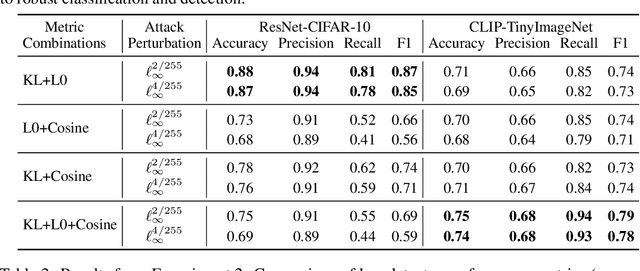
Abstract:Deep neural networks are highly susceptible to adversarial attacks, which pose significant risks to security- and safety-critical applications. We present KoALA (KL-L0 Adversarial detection via Label Agreement), a novel, semantics-free adversarial detector that requires no architectural changes or adversarial retraining. KoALA operates on a simple principle: it detects an adversarial attack when class predictions from two complementary similarity metrics disagree. These metrics-KL divergence and an L0-based similarity-are specifically chosen to detect different types of perturbations. The KL divergence metric is sensitive to dense, low-amplitude shifts, while the L0-based similarity is designed for sparse, high-impact changes. We provide a formal proof of correctness for our approach. The only training required is a simple fine-tuning step on a pre-trained image encoder using clean images to ensure the embeddings align well with both metrics. This makes KOALA a lightweight, plug-and-play solution for existing models and various data modalities. Our extensive experiments on ResNet/CIFAR-10 and CLIP/Tiny-ImageNet confirm our theoretical claims. When the theorem's conditions are met, KoALA consistently and effectively detects adversarial examples. On the full test sets, KoALA achieves a precision of 0.94 and a recall of 0.81 on ResNet/CIFAR-10, and a precision of 0.66 and a recall of 0.85 on CLIP/Tiny-ImageNet.
Shift-Invariant Attribute Scoring for Kolmogorov-Arnold Networks via Shapley Value
Oct 02, 2025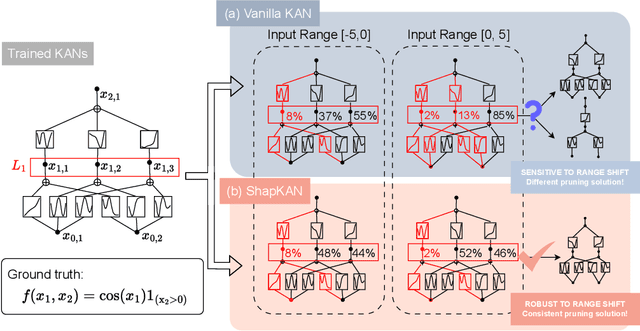

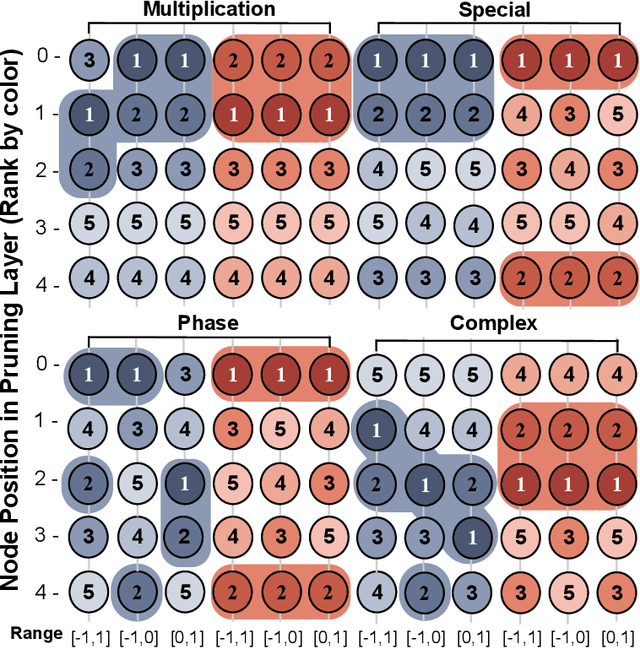
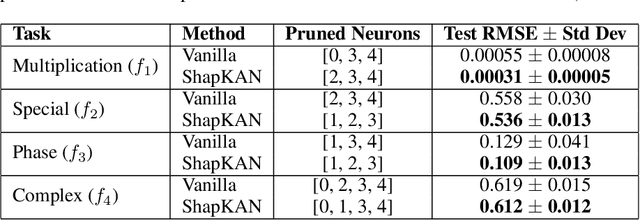
Abstract:For many real-world applications, understanding feature-outcome relationships is as crucial as achieving high predictive accuracy. While traditional neural networks excel at prediction, their black-box nature obscures underlying functional relationships. Kolmogorov--Arnold Networks (KANs) address this by employing learnable spline-based activation functions on edges, enabling recovery of symbolic representations while maintaining competitive performance. However, KAN's architecture presents unique challenges for network pruning. Conventional magnitude-based methods become unreliable due to sensitivity to input coordinate shifts. We propose \textbf{ShapKAN}, a pruning framework using Shapley value attribution to assess node importance in a shift-invariant manner. Unlike magnitude-based approaches, ShapKAN quantifies each node's actual contribution, ensuring consistent importance rankings regardless of input parameterization. Extensive experiments on synthetic and real-world datasets demonstrate that ShapKAN preserves true node importance while enabling effective network compression. Our approach improves KAN's interpretability advantages, facilitating deployment in resource-constrained environments.
CodeBoost: Boosting Code LLMs by Squeezing Knowledge from Code Snippets with RL
Aug 07, 2025Abstract:Code large language models (LLMs) have become indispensable tools for building efficient and automated coding pipelines. Existing models are typically post-trained using reinforcement learning (RL) from general-purpose LLMs using "human instruction-final answer" pairs, where the instructions are usually from manual annotations. However, collecting high-quality coding instructions is both labor-intensive and difficult to scale. On the other hand, code snippets are abundantly available from various sources. This imbalance presents a major bottleneck in instruction-based post-training. We propose CodeBoost, a post-training framework that enhances code LLMs purely from code snippets, without relying on human-annotated instructions. CodeBoost introduces the following key components: (1) maximum-clique curation, which selects a representative and diverse training corpus from code; (2) bi-directional prediction, which enables the model to learn from both forward and backward prediction objectives; (3) error-aware prediction, which incorporates learning signals from both correct and incorrect outputs; (4) heterogeneous augmentation, which diversifies the training distribution to enrich code semantics; and (5) heterogeneous rewarding, which guides model learning through multiple reward types including format correctness and execution feedback from both successes and failures. Extensive experiments across several code LLMs and benchmarks verify that CodeBoost consistently improves performance, demonstrating its effectiveness as a scalable and effective training pipeline.
UAVScenes: A Multi-Modal Dataset for UAVs
Jul 30, 2025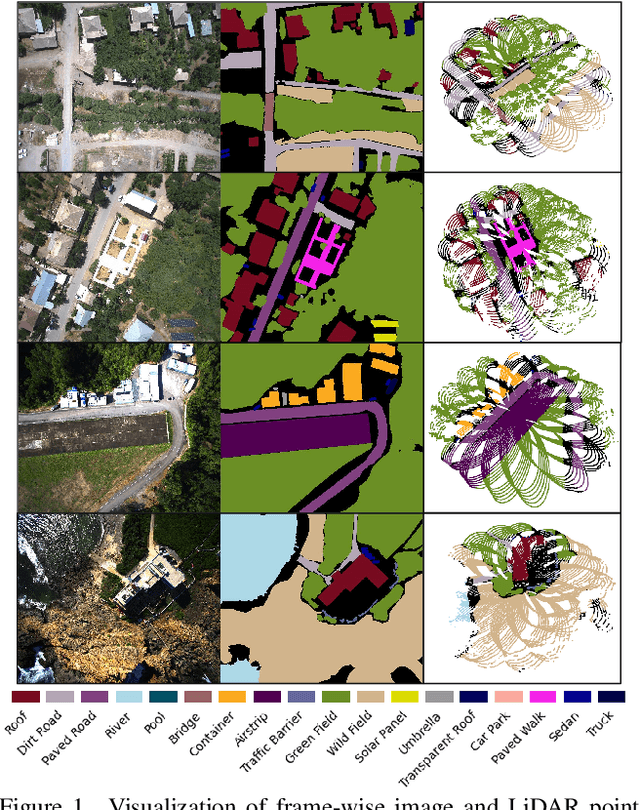
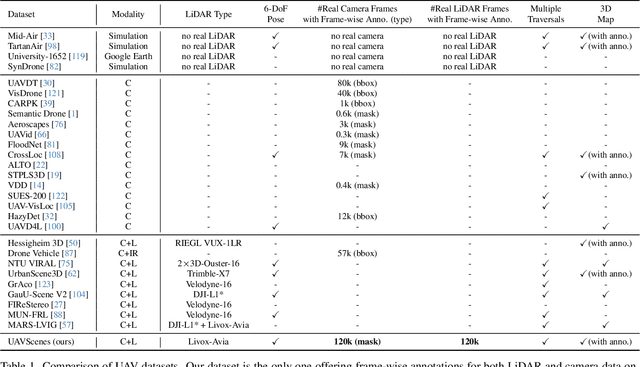
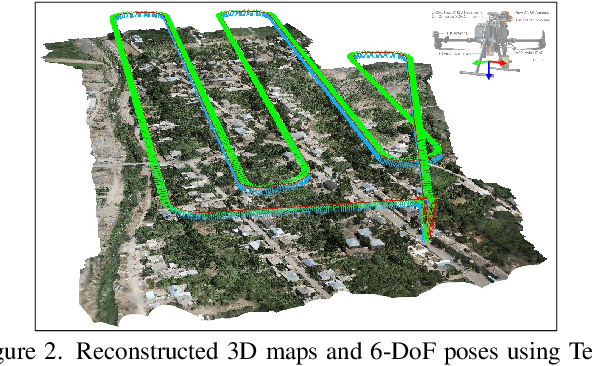
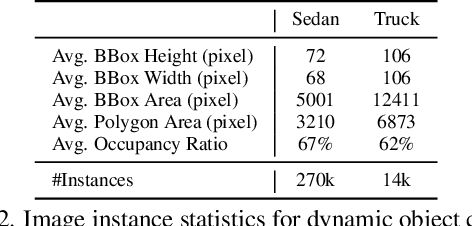
Abstract:Multi-modal perception is essential for unmanned aerial vehicle (UAV) operations, as it enables a comprehensive understanding of the UAVs' surrounding environment. However, most existing multi-modal UAV datasets are primarily biased toward localization and 3D reconstruction tasks, or only support map-level semantic segmentation due to the lack of frame-wise annotations for both camera images and LiDAR point clouds. This limitation prevents them from being used for high-level scene understanding tasks. To address this gap and advance multi-modal UAV perception, we introduce UAVScenes, a large-scale dataset designed to benchmark various tasks across both 2D and 3D modalities. Our benchmark dataset is built upon the well-calibrated multi-modal UAV dataset MARS-LVIG, originally developed only for simultaneous localization and mapping (SLAM). We enhance this dataset by providing manually labeled semantic annotations for both frame-wise images and LiDAR point clouds, along with accurate 6-degree-of-freedom (6-DoF) poses. These additions enable a wide range of UAV perception tasks, including segmentation, depth estimation, 6-DoF localization, place recognition, and novel view synthesis (NVS). Our dataset is available at https://github.com/sijieaaa/UAVScenes
SoftHGNN: Soft Hypergraph Neural Networks for General Visual Recognition
May 21, 2025Abstract:Visual recognition relies on understanding both the semantics of image tokens and the complex interactions among them. Mainstream self-attention methods, while effective at modeling global pair-wise relations, fail to capture high-order associations inherent in real-world scenes and often suffer from redundant computation. Hypergraphs extend conventional graphs by modeling high-order interactions and offer a promising framework for addressing these limitations. However, existing hypergraph neural networks typically rely on static and hard hyperedge assignments, leading to excessive and redundant hyperedges with hard binary vertex memberships that overlook the continuity of visual semantics. To overcome these issues, we present Soft Hypergraph Neural Networks (SoftHGNNs), which extend the methodology of hypergraph computation, to make it truly efficient and versatile in visual recognition tasks. Our framework introduces the concept of soft hyperedges, where each vertex is associated with hyperedges via continuous participation weights rather than hard binary assignments. This dynamic and differentiable association is achieved by using the learnable hyperedge prototype. Through similarity measurements between token features and the prototype, the model generates semantically rich soft hyperedges. SoftHGNN then aggregates messages over soft hyperedges to capture high-order semantics. To further enhance efficiency when scaling up the number of soft hyperedges, we incorporate a sparse hyperedge selection mechanism that activates only the top-k important hyperedges, along with a load-balancing regularizer to ensure balanced hyperedge utilization. Experimental results across three tasks on five datasets demonstrate that SoftHGNN efficiently captures high-order associations in visual scenes, achieving significant performance improvements.
Toward Fair Federated Learning under Demographic Disparities and Data Imbalance
May 14, 2025Abstract:Ensuring fairness is critical when applying artificial intelligence to high-stakes domains such as healthcare, where predictive models trained on imbalanced and demographically skewed data risk exacerbating existing disparities. Federated learning (FL) enables privacy-preserving collaboration across institutions, but remains vulnerable to both algorithmic bias and subgroup imbalance - particularly when multiple sensitive attributes intersect. We propose FedIDA (Fed erated Learning for Imbalance and D isparity A wareness), a framework-agnostic method that combines fairness-aware regularization with group-conditional oversampling. FedIDA supports multiple sensitive attributes and heterogeneous data distributions without altering the convergence behavior of the underlying FL algorithm. We provide theoretical analysis establishing fairness improvement bounds using Lipschitz continuity and concentration inequalities, and show that FedIDA reduces the variance of fairness metrics across test sets. Empirical results on both benchmark and real-world clinical datasets confirm that FedIDA consistently improves fairness while maintaining competitive predictive performance, demonstrating its effectiveness for equitable and privacy-preserving modeling in healthcare. The source code is available on GitHub.
SIM-Shapley: A Stable and Computationally Efficient Approach to Shapley Value Approximation
May 13, 2025



Abstract:Explainable artificial intelligence (XAI) is essential for trustworthy machine learning (ML), particularly in high-stakes domains such as healthcare and finance. Shapley value (SV) methods provide a principled framework for feature attribution in complex models but incur high computational costs, limiting their scalability in high-dimensional settings. We propose Stochastic Iterative Momentum for Shapley Value Approximation (SIM-Shapley), a stable and efficient SV approximation method inspired by stochastic optimization. We analyze variance theoretically, prove linear $Q$-convergence, and demonstrate improved empirical stability and low bias in practice on real-world datasets. In our numerical experiments, SIM-Shapley reduces computation time by up to 85% relative to state-of-the-art baselines while maintaining comparable feature attribution quality. Beyond feature attribution, our stochastic mini-batch iterative framework extends naturally to a broader class of sample average approximation problems, offering a new avenue for improving computational efficiency with stability guarantees. Code is publicly available at https://github.com/nliulab/SIM-Shapley.
GDI-Bench: A Benchmark for General Document Intelligence with Vision and Reasoning Decoupling
Apr 30, 2025Abstract:The rapid advancement of multimodal large language models (MLLMs) has profoundly impacted the document domain, creating a wide array of application scenarios. This progress highlights the need for a comprehensive benchmark to evaluate these models' capabilities across various document-specific tasks. However, existing benchmarks often fail to locate specific model weaknesses or guide systematic improvements. To bridge this gap, we introduce a General Document Intelligence Benchmark (GDI-Bench), featuring 1.9k images across 9 key scenarios and 19 document-specific tasks. By decoupling visual complexity and reasoning complexity, the GDI-Bench structures graded tasks that allow performance assessment by difficulty, aiding in model weakness identification and optimization guidance. We evaluate the GDI-Bench on various open-source and closed-source models, conducting decoupled analyses in the visual and reasoning domains. For instance, the GPT-4o model excels in reasoning tasks but exhibits limitations in visual capabilities. To address the diverse tasks and domains in the GDI-Bench, we propose a GDI Model that mitigates the issue of catastrophic forgetting during the supervised fine-tuning (SFT) process through a intelligence-preserving training strategy. Our model achieves state-of-the-art performance on previous benchmarks and the GDI-Bench. Both our benchmark and model will be open source.
Chameleon: Fast-slow Neuro-symbolic Lane Topology Extraction
Mar 10, 2025Abstract:Lane topology extraction involves detecting lanes and traffic elements and determining their relationships, a key perception task for mapless autonomous driving. This task requires complex reasoning, such as determining whether it is possible to turn left into a specific lane. To address this challenge, we introduce neuro-symbolic methods powered by vision-language foundation models (VLMs). Existing approaches have notable limitations: (1) Dense visual prompting with VLMs can achieve strong performance but is costly in terms of both financial resources and carbon footprint, making it impractical for robotics applications. (2) Neuro-symbolic reasoning methods for 3D scene understanding fail to integrate visual inputs when synthesizing programs, making them ineffective in handling complex corner cases. To this end, we propose a fast-slow neuro-symbolic lane topology extraction algorithm, named Chameleon, which alternates between a fast system that directly reasons over detected instances using synthesized programs and a slow system that utilizes a VLM with a chain-of-thought design to handle corner cases. Chameleon leverages the strengths of both approaches, providing an affordable solution while maintaining high performance. We evaluate the method on the OpenLane-V2 dataset, showing consistent improvements across various baseline detectors. Our code, data, and models are publicly available at https://github.com/XR-Lee/neural-symbolic
ERetinex: Event Camera Meets Retinex Theory for Low-Light Image Enhancement
Mar 04, 2025Abstract:Low-light image enhancement aims to restore the under-exposure image captured in dark scenarios. Under such scenarios, traditional frame-based cameras may fail to capture the structure and color information due to the exposure time limitation. Event cameras are bio-inspired vision sensors that respond to pixel-wise brightness changes asynchronously. Event cameras' high dynamic range is pivotal for visual perception in extreme low-light scenarios, surpassing traditional cameras and enabling applications in challenging dark environments. In this paper, inspired by the success of the retinex theory for traditional frame-based low-light image restoration, we introduce the first methods that combine the retinex theory with event cameras and propose a novel retinex-based low-light image restoration framework named ERetinex. Among our contributions, the first is developing a new approach that leverages the high temporal resolution data from event cameras with traditional image information to estimate scene illumination accurately. This method outperforms traditional image-only techniques, especially in low-light environments, by providing more precise lighting information. Additionally, we propose an effective fusion strategy that combines the high dynamic range data from event cameras with the color information of traditional images to enhance image quality. Through this fusion, we can generate clearer and more detail-rich images, maintaining the integrity of visual information even under extreme lighting conditions. The experimental results indicate that our proposed method outperforms state-of-the-art (SOTA) methods, achieving a gain of 1.0613 dB in PSNR while reducing FLOPS by \textbf{84.28}\%.
 Add to Chrome
Add to Chrome Add to Firefox
Add to Firefox Add to Edge
Add to Edge